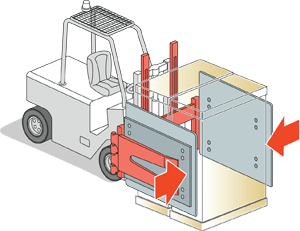

Emphasize the importance of following manufacturer guidelines, safety protocols, and maintenance procedures. Provide proper training to forklift operators on the correct usage and operation of the fork positioner.


Verify that all safety features, such as pressure relief valves or limit switches, are functioning correctly. Ensure that the positioner remains securely locked in the desired position during operation. Perform safety checks on the fork positioner, such as checking the operation of safety locks or latches. A clean fork positioner helps prevent premature wear and maintains optimal performance. Pay special attention to the sliding surfaces, hydraulic components, and other critical areas. Regularly clean the equipment using appropriate cleaning methods and materials. Keep the fork positioner clean from debris, dirt, and other contaminants. Inspect hydraulic hoses and fittings for any signs of leaks or damage and repair or replace them promptly. Replace the hydraulic fluid as recommended by the manufacturer. Check the hydraulic fluid level and quality periodically. If the fork positioner is equipped with a hydraulic system, regular maintenance is crucial. Proper lubrication helps reduce friction, prolong the lifespan of the components, and maintain smooth operation. Apply the appropriate lubricants to the necessary points, such as pivot points, bearings, and sliding surfaces. Promptly address any issues to prevent further damage or potential failures.įollow the manufacturer's recommendations for lubrication intervals and procedures. Inspect the mounting hardware, hydraulic hoses, cylinders, and other critical parts. Regular Inspections:Ĭonduct regular visual inspections of the forklift fork positioner to identify any signs of wear, damage, or loose components. Make any necessary adjustments to ensure optimal alignment and performance. Verify that the positioner can move the forks smoothly and precisely to the desired positions.
#Forklift clamp instructions full
Once the fork positioner is installed, test its operation before putting it into full use. This alignment is necessary for the smooth operation of the fork positioner and to avoid any unnecessary strain on the equipment.

A secure mounting is essential to maintain the stability and performance of the fork positioner.Īlign the forks of the forklift properly to ensure they are parallel and level. Ensure that all bolts, pins, and screws are tightened to the specified torque values. Use appropriate tools and hardware provided by the manufacturer. Repair or replace any defective parts before proceeding.įollow the manufacturer's instructions to securely mount the fork positioner onto the forklift. Check for any damages, wear, or loose components that may affect the installation or operation of the fork positioner. Consider factors such as the weight capacity, fork size, and mounting requirements.īefore installing the fork positioner, inspect the forklift to ensure it is in proper working condition. Each manufacturer may have different installation requirements and guidelines.Įnsure that the selected fork positioner attachment is suitable for your specific application and compatible with your forklift or material handling equipment. Start by thoroughly reading and understanding the manufacturer's installation instructions specific to the fork positioner model you have. In this news, we will discuss some important installation and maintenance tips for fork positioners. Proper installation and regular maintenance help prevent malfunctions, minimize downtime, and maximize the efficiency of the equipment. Installation and maintenance are crucial aspects of ensuring the optimal performance and longevity of a fork positioner.


 0 kommentar(er)
0 kommentar(er)
